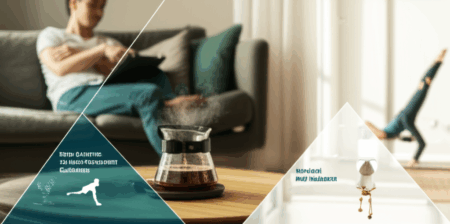As a growing body of research consistently demonstrates, physical activity is a potent, accessible, and often underutilized tool in the fight against anxiety and depression. Beyond its well-known physical benefits, regular exercise profoundly impacts mental well-being, offering a multifaceted approach to alleviating symptoms and fostering resilience. The mechanisms by which exercise achieves these effects are complex, involving intricate physiological and psychological pathways that work in concert to promote a healthier mind.

The Neurochemical Symphony: Exercise and Brain Chemistry
One of the most immediate and impactful ways exercise influences mood is through its effect on brain chemistry. Physical activity triggers a cascade of neurochemical changes that can directly combat the imbalances often associated with anxiety and depression.
Endorphin Release
Often referred to as the body’s natural “feel-good” chemicals, endorphins are neurotransmitters produced in the brain and spinal cord that act as natural painkillers and mood elevators. When you engage in physical activity, your body releases endorphins, which interact with receptors in your brain, leading to feelings of happiness and reduced perceptions of pain and stress. This “runner’s high” is a prime example of endorphins at work, enhancing your sense of well-being and reducing feelings of discomfort. Studies have shown that increased endorphin levels are associated with decreased stress and anxiety and improved self-image. Low endorphin levels, conversely, can be linked to symptoms of depression and anxiety.
Serotonin and Dopamine Regulation
Exercise also significantly influences the levels of other crucial neurotransmitters, including serotonin and dopamine. Serotonin plays a vital role in regulating mood, sleep, appetite, and social behavior. Depression is frequently linked to low serotonin levels, and exercise can help increase these levels, thereby improving mood and reducing depressive symptoms. Dopamine, on the other hand, is associated with pleasure, motivation, and the brain’s reward system. Exercise boosts dopamine levels, enhancing positive emotions and aiding in the reduction of depression symptoms. The interplay of these neurotransmitters contributes to improved mood stability and emotional resilience.
Norepinephrine and Stress Response
Norepinephrine is another neurotransmitter that helps regulate alertness and the body’s stress response. Imbalances in norepinephrine are often seen in anxiety disorders. Exercise can help modulate norepinephrine activity, contributing to a more balanced stress response and potentially alleviating anxiety symptoms.

Beyond Neurotransmitters: Deeper Brain Changes
The benefits of exercise extend beyond immediate neurochemical shifts, leading to more profound structural and functional changes within the brain itself.
Neurogenesis and BDNF
Physical activity promotes neurogenesis, the growth of new brain cells, particularly in the hippocampus, a brain region critical for memory and emotional regulation. Exercise also boosts levels of brain-derived neurotrophic factor (BDNF), a protein crucial for the growth, maintenance, and survival of brain cells. BDNF is often depleted in individuals with depression, and by increasing its levels, exercise enhances brain function and helps alleviate depressive symptoms. Higher levels of BDNF are associated with improved cognitive function, learning, and memory, and lower levels of depression and anxiety.
Reduced Inflammation
Chronic inflammation has been increasingly linked to the development and progression of depression and anxiety. Regular physical activity can help mitigate this by reducing the levels of pro-inflammatory cytokines, which are signaling molecules that promote inflammation. Exercise induces anti-inflammatory effects through various pathways, contributing to better mental health and a reduction in depressive symptoms. Moderate-intensity exercise, in particular, may be optimal for promoting mental health by decreasing inflammation.
Cortisol Regulation and HPA Axis Modulation
Exercise can also help regulate the body’s stress hormones, primarily cortisol. Elevated cortisol levels are frequently observed in individuals experiencing anxiety and depression. Physical activity helps to lower cortisol, reducing the negative effects of stress and mitigating stress responses. This modulation of the hypothalamic-pituitary-adrenal (HPA) axis, which controls the body’s reaction to stress, plays a significant role in improving emotional stability.

The Psychological & Behavioral Advantages
Beyond the physiological adaptations, exercise offers a wealth of psychological and behavioral benefits that contribute to improved mental health.
Stress Reduction and Improved Coping
Exercise is a highly effective stress reliever. It can provide a healthy outlet for frustrations and help the body better cope with stress. When the body is reacting to stress, such as during the “fight-or-flight” response, exercise can offer relief. Regular physical activity helps to bring the sympathetic and parasympathetic nervous systems back into balance, easing muscle tension and calming the mind. This improved ability to deal with common stressors can significantly enhance overall quality of life.
Distraction and Mindful Movement
Engaging in physical activity can serve as a powerful distraction from negative thoughts and worries that often fuel anxiety and depression. Focusing on the movement itself, the rhythm of breathing, or external surroundings can help break the cycle of rumination. Activities like yoga and tai chi, with their emphasis on breath and mindful movement, can be particularly effective in calming the mind and promoting relaxation.
Enhanced Self-Esteem and Confidence
Meeting exercise goals, even small ones, can significantly boost self-confidence and self-esteem. Achieving physical accomplishments, getting in shape, and feeling better about one’s body image all contribute to a more positive self-perception. This sense of mastery and accomplishment can be a powerful antidote to the feelings of helplessness often associated with mental health struggles.
Improved Sleep Quality
Sleep disturbances are a common comorbidity with anxiety and depression. Regular exercise can significantly improve sleep quality, including the deep and restorative stages of sleep. Good sleep, in turn, is crucial for mood regulation and overall mental well-being. Studies suggest that consistent daily exercise yields more significant benefits for achieving high-quality rest.
Social Interaction and Support
Many forms of exercise offer opportunities for social interaction, which can combat feelings of loneliness and isolation. Joining a fitness class, playing a team sport, or even just sharing a friendly greeting with others during a walk can provide valuable social support and improve mood. While some research suggests that social interaction might be even more impactful than exercise alone for mental well-being, the combination of both can be particularly beneficial.

Integrating Exercise into a Mental Wellness Routine
The evidence overwhelmingly supports exercise as a vital component in the holistic treatment and prevention of anxiety and depression. It is important to note that while exercise is a powerful tool, it does not replace professional talk therapy or medication when needed. Instead, it serves as a valuable complementary strategy that can enhance the effectiveness of other treatments.
Types of Exercise and Intensity
Virtually any physical activity that gets you moving can boost your mood. However, certain types and intensities of exercise have shown particular efficacy. Both aerobic exercise (e.g., brisk walking, jogging, cycling, swimming) and resistance training (strength training, weights) are beneficial.
- Aerobic Exercise: Stimulates the release of endorphins and can significantly reduce anxiety and depression. Even short, moderate-intensity aerobic activity, such as a 10-15 minute walk, can provide immediate mood benefits.
- Resistance Training: Contributes to increased levels of neurotransmitters like serotonin and dopamine, and can improve self-esteem and body confidence. Research shows resistance training can reduce anxiety and worry with immediate effects.
- Mind-Body Practices: Yoga and Tai Chi emphasize breathing and mindful movement, which can effectively reduce stress, regulate mood, and promote a mind-body connection.
The most beneficial exercise intensity depends on individual factors, but low, moderate, and high-intensity exercises all contribute to alleviating symptoms. Some studies suggest that moderate-intensity exercise may be optimal for reducing inflammation and promoting mental health. For anxiety, high-intensity interval training (HIIT) has been shown to be particularly effective.
Recommendations for Consistency
The mental health benefits of exercise are often sustained with long-term adherence. Experts recommend that adults aim for at least 150 minutes of moderate-intensity physical activity or 75 minutes of vigorous-intensity physical activity per week, along with muscle-strengthening exercises on two days a week. These minutes can be accumulated in shorter bursts throughout the day; for example, three 10-minute walks can be as beneficial as one 30-minute walk. The key is to find activities that are enjoyable and can be consistently incorporated into one’s routine.
Choosing familiar and comfortable environments can also help in starting an exercise program, and exercising with others can increase motivation and adherence. Ultimately, any physical activity, even small amounts, is better than none for boosting mental well-being.
In conclusion, exercise is a powerful, evidence-based intervention for managing and reducing symptoms of anxiety and depression. By positively influencing brain chemistry, promoting beneficial neurobiological changes, and offering significant psychological advantages, physical activity provides a holistic pathway toward improved mental health and overall quality of life.







